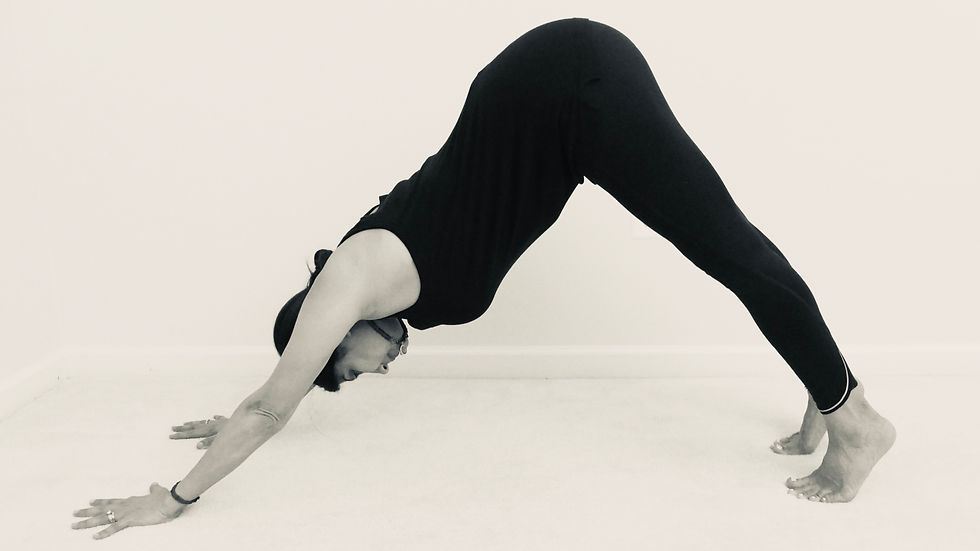HOME YOGA PRACTICE
- Rimmi Singh
- Jan 1, 2020
- 5 min read
Updated: Apr 16, 2020

Practicing yoga at home empowers you and gives you freedom to explore. If you want to build a consistent home practice, start by choosing a few poses that feel good, so you are eager, not anxious, to step on your mat.
Familiarize yourself with some of these poses and create a practice that fits your needs. Choose a pose or two from class and add it to your practice. Most of all enjoy and relax. ~ Namaste, Rimmi
Bitilasana Marjaryasana
(Cat & Cow Pose)
Benefits: This pose increases flexibility in the neck, shoulder and spine. The movement also stretches the muscles of the hips, back, abdomen, chest and lungs. Stimulates the kidneys and adrenal glands.
How to do it: These are actually two poses, one flowing into the other. Begin on your hands and knees, keeping your hands underneath your shoulders and your feet under your hips. As you inhale, let the spine curve downward, dropping the stomach low, and lift your head up. Stretch gently. As you exhale, move into the cat positions by drawing the spine up and pulling the chest up. Repeat 4-6 times, flowing smoothly from one to the other.
Tadasana
(Mountain Pose)
Benefits: This is the starting pose for all standing poses. But it's useful to practice Tadasana as a pose in itself.
How to do it:
Stand with your feet slightly apart and parallel.
Lift and spread your toes, then lay them softly down on your mat. Root and ground through the feet with the weight balanced evenly on the feet. Stretch your arms towards the floor and engage your abdominals. Hold for 5 - 8 breaths to get focused and ready for deeper poses
Uttanasana
(Forward Bend Pose)
Benefits:
This asana stretches the hamstrings and lower back, rests the heart, relaxes mind and body.

How to do it: Stand in Mountain pose. Inhale and raise the arms overhead. Exhale, bend your knees slightly and fold your torso over your legs, moving from the hips, not the lower back.
Place your hands on blocks, or your legs or by your feet. Lift the kneecaps and take your head as close into your knees as possible. Hold the pose for 5 breaths. To come out, place your hands on your waist, and gently lift yourself.
Virabhadrasana II
(Warrior Pose II)
Benefits: This pose strengthens the legs and arms, opens the hips and chest. It improves balance and concentration.

How to do it: Begin in Mountain pose. Step your feet 3-4 feet apart. Turn your left foot inwards slightly and turn your right foot 90° outwards so that it is pointing straight out. Exhale and bend your right knee, keeping it directly above your right ankle so the shin is perpendicular. Raise your arms shoulder height and turn your head to look beyond your right hand. Take 4-5 breaths, then straighten your right leg and lower your arms. Repeat on the left side.
Parsvakonasana
( Extended Side Angle Pose)
Benefits: This pose stretches and strengthens the legs, knees and ankles. It stretches the spine, groins, chest and shoulders.

How to do it:
From Mountain pose come to Warrior II pose - with your left foot turned inwards slightly and your right foot turned out at 90° angle. Place your right hand to the outside of your right foot (use a block, if needed). Extend your left arm over your left ear with your palms facing down. Attempt to create a diagonal line from your left foot all the way to your left fingertips. Take 4-5 breaths, then straighten your right leg and lower your arms. Repeat on the left side.
Trikonasana
(Triangle Pose)
Benefits: This pose stretches for the hamstrings, groins, hips and shoulders. It helps relieve lower back pain and improves digestion.

How to do it: Begin in Mountain pose. Step your feet 3-4 feet apart. Turn your left foot inwards slightly and turn your right foot 90° outwards so that it is pointing straight out. Slowly bend from your right hip crease, sliding your right hand down your right leg, keeping both legs straight. When you have reached your edge, take your left arm up. Turn your head to look up at your left arm. Take 4-5 breaths, then lift yourself up. Repeat on the left side.
Adho Mukha Svanasana
( Downward Facing Dog Pose)
Benefits: This pose stretches the hamstrings and spine. It strengthens the back and arms, and opens the lungs and heart.

How to do it:
Begin on your hands and knees, keeping your hands forward of your shoulders and your feet under your hips. Curl the toes under and lift yourself up and back into downward facing dog pose. Press firmly into your hands and lengthen up through your torso, reaching your pelvis up towards the ceiling. Gently begin to lengthen your legs, being gentle with yourself. Hold for 4-5 breaths. To release, gently bend your knees and come back to your hands and knees.
Bhujangasana
(Cobra Pose)
Benefits: This pose stretches the spine, strengthens the back and arms, and opens the lungs and the heart.

How to do it:
Lie on your stomach keeping your legs straight, toes pointed, hands by your chest. Inhaling, slowly lift your head and chest into a baby cobra. Relax your shoulders, draw the shoulder blades together and down your back and see if you can lift anymore. Keep your buttock muscles engaged to protect your lower back. Hold the asana for 5 breaths and then slowly come down. Repeat 2-4 times.
Balasana
(Child Pose)
Benefits: This pose stretches and strengthens the hips, thighs and ankles. It helps to relieve back pain and stress. It improves circulation.

How to do it:
Begin on your hands and knees with your toes pointed and touching. Open your knees hip width apart. Slowly move your buttocks towards your heels and your forehead toward the floor. Extend your arms. If needed, you can support your forehead on a block or your arms. Hold the pose for 5-8 breaths and then slowly come onto all fours.
Savasana
(Corpse Pose)
Benefits: This relaxes the body, quietens the mind and relieves stress and anxiety.
How to do it:
Usually performed at the end of a practice, the goal is conscious relaxation. Begin by lying on your back, feet slightly apart, arms at your sides with palms facing up. Close your eyes and take several slow, deep breaths. Allow your body to sink into the ground. Try focusing on a specific part of the body and willing it to relax. For example, start with your feet, imagine the muscles and skin relaxing, letting go and slowly melting into the floor. From your feet, move on to your calves, thighs and so on up to your face and head. Then simply breathe and relax. Stay in the pose for at least 8-10 minutes.










Thank you Rimmi.
Thank you for posting and encouraging home yoga practice! Much appreciated.